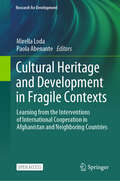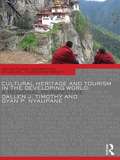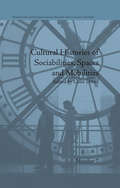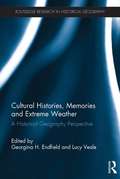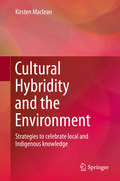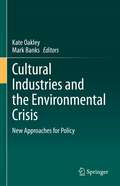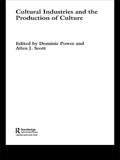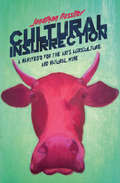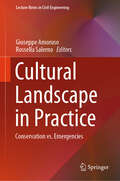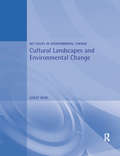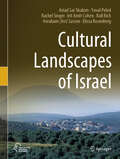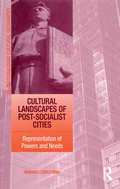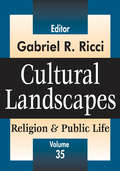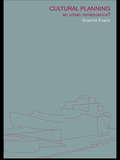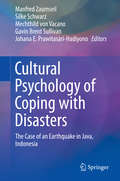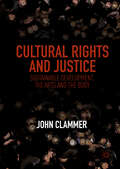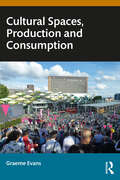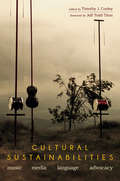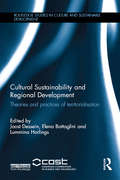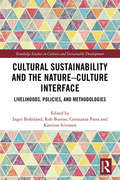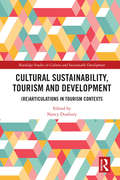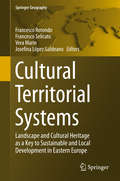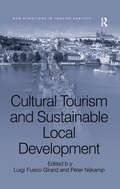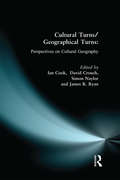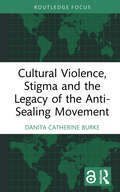- Table View
- List View
Cultural Heritage and Development in Fragile Contexts: Learning from the Interventions of International Cooperation in Afghanistan and Neighboring Countries (Research for Development)
by Mirella Loda Paola AbenanteThis open access book discusses cooperation strategies for safeguarding cultural heritage in nations facing diverse forms of fragility. Through case studies and a critical analysis, it explores preserving cultural heritage to spur regional socioeconomic development and community empowerment, focusing on the Middle East and Pakistan, with an in-depht exploration of the World Heritage site of Bamiyan, Afghanistan. The first section offers an overview of cultural heritage protection efforts since UNESCO designated Bamiyan Valley as a World Heritage Site in 2003, reflecting on challenges and successes before Taliban rule. The second section turns to the present situation, analysing the inerplay between heritage preservation, community involvement and policies addressing urban and demographic growth. The third section provides a review of relevant examples of cultural heritage preservation in the Middle East and Pakistan by the Italian Agency for Development Cooperation, UNESCO, and international NGOs. It highlights the relationship between heritage protection, sustainable development and the mitigation of social and economic fragilities. In the concluding section, the book synthesizes research findings and operational approaches, providing a nuanced understanding of the cultural heritage, development, and fragility in the Middle East. Concluding, in the fourth section, the book offers a comprehensive report on main methodological findings, also conferrable to other contexts both in terms of future research and operational activities.
Cultural Heritage and Tourism in the Developing World: A Regional Perspective (Contemporary Geographies of Leisure, Tourism and Mobility)
by Dallen J. Timothy Gyan P. NyaupaneCultural Heritage and Tourism in the Developing World is the first book of its kind to synthesize global and regional issues, challenges, and practices related to cultural heritage and tourism, specifically in less-developed nations. The importance of preservation and management of cultural heritage has been realized as an increasing number of tourists are visiting heritage attractions. Although many of the issues and challenges developing countries face in terms of heritage management are quite different from those in the developed world, there is a lack of consolidated research on this important subject. This seminal book tackles the issues through theoretical discourse, ideas and problems that underlay heritage tourism in terms of conservation, management, economics and underdevelopment, politics and power, resource utilization, colonialism, and various other antecedent notions that have shaped the development of heritage tourism in the less-developed regions of the world. The book is comprised of two sections. The first section highlights the broader conceptual underpinnings, debates, and paradigms in the realm of heritage tourism in developing regions. The chapters of this section examine heritage resources and the tourism product; protecting heritage relics, places and traditions; politics of heritage; and the impacts of heritage tourism. The second section examines heritage tourism issues in specific regions, including the Pacific Islands, South Asia, the Caribbean, China and Northeast Asia, South-East Asia, Sub-Saharan Africa, Central and Eastern Europe, the Middle East and North Africa, and Latin America. Each region has unique histories, cultures, political traditions, heritages, issues and problems, and the way these issues are tackled vary from place to place. This volume develops frameworks that are useful tools for heritage managers, planners and policy-makers, researchers, and students in understanding the complexity of cultural heritage and tourism in the developing world. Unlike many other books written about developing regions, this book provides insiders’ perspectives, as most of the empirical chapters are authored by the individuals who live or have lived in the various regions and have a greater understanding of the region’s culture, history, and operational frameworks in the realm of cultural heritage. The richness of this ‘indigenous’ or expert knowledge comes through as each regional overview elucidates the primary challenges and opportunities facing heritage and tourism managers in the less affluent areas of the world.
Cultural Histories of Sociabilities, Spaces and Mobilities (Studies for the International Society for Cultural History #7)
by Colin DivallFor the majority of us the opportunity to travel has never been greater, yet differences in mobility highlight inequalities that have wider social implications. Exploring how and why attitudes towards movement have evolved across generations, the case studies in this essay collection range from medieval to modern times and cover several continents.
Cultural Histories, Memories and Extreme Weather: A Historical Geography Perspective (Routledge Research in Historical Geography)
by Lucy Veale Georgina EndfieldExtreme weather events, such as droughts, strong winds and storms, flash floods and extreme heat and cold, are among the most destructive yet fascinating aspects of climate variability. Historical records and memories charting the impacts and responses to such events are a crucial component of any research that seeks to understand the nature of events that might take place in the future. Yet all such events need to be situated for their implications to be understood. This book is the first to explore the cultural contingency of extreme and unusual weather events and the ways in which they are recalled, recorded or forgotten. It illustrates how geographical context, particular physical conditions, an area’s social and economic activities and embedded cultural knowledges and infrastructures all affect community experiences of and responses to unusual weather. Contributions refer to varied methods of remembering and recording weather and how these act to curate, recycle and transmit extreme events across generations and into the future. With international case studies, from both land and sea, the book explores how and why particular weather events become inscribed into the fabric of communities and contribute to community change in different historical and cultural contexts. This is valuable reading for students and researchers interested in historical and cultural geography, environmental anthropology and environmental studies.
Cultural Hybridity and the Environment: Strategies to celebrate local and Indigenous knowledge
by Kirsten MacleanThis book highlights the importance of diversity in overcoming issues of social and environmental degradation. It presents conceptual and practical strategies to celebrate local and Indigenous knowledge for improved community development and environmental management. David Harvey has proclaimed, "The geography we make must be a peoples' geography. " This clarion call challenges geographers around the world to consider the power and potential of geographic knowledge as the basis for social action - a call this book answers, providing readers the theoretical and conceptual tools needed to understand the social world and empowering them to mobilize social change. The author uses empirical case studies of two environmental management and community development projects to document how knowledge generation is "essentially locally situated and socially derived. " In doing so she charts a path for moving beyond what Vandana Shiva so aptly describes as "monocultures of the mind. " The book argues that local and Indigenous knowledge must not be seen in opposition to scientific knowledge, as none of these knowledge traditions hold all the answers to localized socio-environmental problems. Rather, as the author explores through a set of processes and strategies to enable, support and celebrate 'cultural hybridity' at the local environmental governance scale, these respective knowledge systems can learn to speak to each other. Such dialogue has the potential to support more sustainable outcomes at multiple environmental governance locales. This book will be of interest to everyone involved in environmental policy, planning or politics, and for those who want to make this planet a more sustainable and just place.
Cultural Industries and the Environmental Crisis: New Approaches for Policy
by Kate Oakley Mark BanksThis volume critiques the current model of the creative economy, and considers alternative models that may point to greener, cleaner, more sustainable and socially just cultural and creative industries. Aimed at the nexus of cultural and environmental concerns, the book assesses the ways in which arts and cultural activities can help develop ideas of the ‘good life’ beyond excessive and unsustainable material consumption, and explores the complex interactions between cultural prosperity, place and the quality (and availability) of employment, leisure and the rights to self-expression. Adopting a deliberately wide and inclusive interdisciplinary and international perspective, contributors to this volume showcase current and future ways of ‘doing’ creative economy, ecologically, otherwise and differently. In 11 chapters, the book outlines some of the most relevant arguments from among the growing literature that critically analyzes the current creative economy, with a focus on issues of gentrification, inequality and environment. This volume is timely, as it emerges into a political and economic context that is seeking desperately to ‘reboot’ the economy, re-establish ‘business as usual’ and to do so partly through significant investment and expansion in the creative economy. The book will be suitable for upper level undergraduates and postgraduates studying a wide range of topics, including: cultural and creative industries, media and communications, cultural studies, cultural policy, human geography, environmental humanities and environmental policy, and will be of further interest to arts professionals, creative economy researchers and policymakers. The chapter “Towards a New Paradigm of the Creative City or the Same Devil in Disguise? Culture-led Urban (Re)development and Sustainability” is available open access under a Creative Commons Attribution 4.0 International License via link.springer.com.
Cultural Industries and the Production of Culture (Routledge Studies in International Business and the World Economy #Vol. 33)
by Dominic Power Allen J. ScottSince the Second World War there has been considerable growth in the importance of non-manufacturing based forms of production to the performance of many Western economies. Many countries have seen increased contributions being made by industries such as the media, entertainment and artistic sectors. Gathering together a leading international, multi disciplinary team of researchers, this informative book presents cutting-edge perspectives on how these industries function, their place in the new economy and how they can be harnessed for urban and regional economic and social development.
Cultural Insurrection: A Manifesto for Arts, Agriculture, and Natural Wine
by Jonathan NossiterFrom the director of Mondovino, a lively discussion of the expanding world of natural wine that considers the movement as a potential remedy for our current cultural crisis. What if, ten years from now, an artist--a filmmaker, for example--will have become as marginal and anachronistic as a blacksmith? What if the actors in the cultural world are on the brink of extinction, not about to disappear like prehistoric animals, but worse--submitting to the status quo? Absorbed by a marketplace that increasingly devalues true artistic work?In Cultural Insurrection, award-winning filmmaker and sommelier Jonathan Nossiter considers these questions and offers a solution inspired by the rebellious, innovative figures transforming the way we produce and consume wine. This new generation of artisans, working closely with the earth to create exceptional natural wines, has assumed the role of dissenters that artists have abandoned, and we should look to them in order to revitalize contemporary art.
Cultural Landscape in Practice: Conservation vs. Emergencies (Lecture Notes in Civil Engineering #26)
by Rossella Salerno Giuseppe AmorusoThis book approaches cultural landscape as a driver for societal challenges, economic development, social inclusion, place assessment and heritage conservation. It explores issues stemming from the relation between conservation and emergencies, and identifies descriptive tools for conveying knowledge and generating new expertise, heritage skills, seismic culture and social resilience. The documentation of landscapes, due in part to new technologies, increasingly involves integrated methodologies and graphic outcomes such as Heritage-BIM, advanced 3D modeling, and immersive environments. According to recent UNESCO recommendations, the process of mapping places is a necessary prerequisite for design action, and also includes the emotional and perceptive dimension, so as to represent space through visual thought and produce graphic materials. The chapters presented here will ultimately support efforts to overcome the emergency phase of reconstruction after natural disasters and, by exploring relevant issues in recent studies, will describe emerging tools that can help inspire practices that concern not only agrarian and urban, but also historic urban landscapes. The work also presents planning tools to help preserve the integrity and authenticity of urban heritages. The book will benefit all scholars and practitioners who are involved in the process of understanding, designing and transforming places, and will foster an international exchange of research, case studies, and best practices to confront the practical challenges involved in keeping cultural landscapes alive.
Cultural Landscapes and Environmental Change (Key Issues in Environmental Change)
by Lesley HeadCultural landscapes are usually understood within physical geography as those transformed by human action. As human influence on the earth increases, advances in palaeocological reconstruction have also allowed for new interpretations of the evidence for the earliest human impacts on the environment. It is essential that such evidence is examined in the context of modern trends in social sciences and humanities. This stimulating new book argues that convergence of the two approaches can provide a more holistic understanding of long-term physical and human processes.Split into two major sections, this book attempts to bridge the gap between the sciences and humanities. The first section, provides an analysis of the methodological tools employed in examining processes of environmental change. Empirical research in the fields of palaecology and Quaternary studies is combined with the latest theoretical views of nature and landscape occurring in cultural geography, archaeology and anthropology. The author examines the way in which environmental management decisions are made. The book then moves on to discuss the relevance of this perspective to contemporary issues through a wide variety of international case studies, including World Heritage protection, landscape preservation, indigenous people and cultural tourism.
Cultural Landscapes of Israel
by Aviad Sar Shalom Yuval Peled Rachel Singer Irit Amit-Cohen Rafi Rich Avraham (Avi) Sasson Elissa RosenbergThis book introduces an inventory of proposed cultural landscapes in Israel, which have been identified, researched and mapped by the Israel Nature and Parks Authority. The categories as defined by the Operational Guidelines of the World Heritage Convention are used to classify the cultural landscapes and provide a framework to determine their significance on a global, regional and local scale. This volume explains the local planning framework and highlights the present complexities in a local context. A number of innovative case studies on the management of sites illustrate how it is possible to bring a range of stakeholders together with public participation, ensuring that appropriate decisions are made regarding the steps necessary for the future of cultural landscapes in Israel. This book appeals to planners and heritage conservationists equally as to students and post graduates in the fields of landscape planning and architecture, geography, archaeology and many related areas.
Cultural Landscapes of Post-Socialist Cities: Representation of Powers and Needs
by Mariusz CzepczynskiThe cultural landscapes of Central European cities reflect over half a century of socialism and are marked by the Marxists' vision of a utopian landscape. Architecture, urban planning and the visual arts were considered to be powerful means of expressing the 'people's power'. However, since the velvet revolutions of 1989, this urban scenery has been radically transformed by new forces and trends, infused by the free market, democracy and liberalization. This has led to 'landscape cleansing' and 'recycling', as these former communist nations used new architectural, functional and social forms to transform their urbanscapes, their meanings and uses. Comparing case studies from different post-socialist cities, this book examines the culturally conditional variations between local powers and structures despite the similarities in the general processes and systems. It considers the contemporary cultural landscapes of these post-socialist cities as a dynamic fusion of the old communist forms and new free-market meanings, features and democratic practices, of global influences and local icons. The book assesses whether these urbanscapes clearly reflect the social, cultural and political conditions and aspirations of these transitional countries and so a critical analysis of them provides important insights.
Cultural Landscapes: Religion and Public Life (Religion And Public Life Ser.)
by Gabriel R. RicciAdualism between man and nature has been a persistent feature of Western thought and spirituality from ancient times to the present. The opposition of mind and body, consciousness and world has tended to obscure the ways in which humans are ecologically part of interconnected systems, some of which are obvious while others operate in hidden but life-sustaining ways. Cultural Landscapes explores the physical ways in which we are intimately linked to the land and the intellectual and aesthetic connections human consciousness has with the landscape. Following the editor's introductory essay, the lead article by Jame Schaeffer, "Quest for the Common Good: A Collaborative Public Theology for a Life-Sustaining Climate," assesses the lightning rod issue of global warming in the context of a public and ecumenical theology and sets the tone for this normative assessment of our relationship with nature. Likewise, David Kenley's essay, "Three Gorges be Dammed: The Philosophical Roots of Environmentalism in China," reveals the traditional philosophical and cultural values that can sustain a vital environmentalism in the East. David Brown's historical insights into the use of the American landscape to define historical writing complement Patricia Likos-Ricci's historical treatment of nineteenth-century landscape painting and the first call to preserve wilderness in the United States. Matt Willen, "An Feochszn," and David Martinez, "What Worlds are Made of: The Lakota Sense of Place," both demonstrate how space is transformed into place through song and mythic tales. On a metaphysical note, Andreas Philippopoulos-Mihalopolos' essay "On the Line of the Horizon, Anxiety in de Chirico's Metaphysical Spaces," provides the reader with psychological and existential insights into the disorienting paintings of de Chirico, and Gabriel Ricci's concluding essay tours the landscape that underpins Heidegger's ontological speculations. The contributions to this volume are posited on the belief that culture, society, and human history are ultimately rooted in the natural world. This integration may explain why humanity has always looked to nature for moral and ethical guidelines. Gabriel R. Ricci is associate professor of humanities and the chair of the Department of History at Elizabethtown College in Pennsylvania. He is the author of Time Consciousness: The Philosophical Uses of History, published by Transaction.
Cultural Planning: An Urban Renaissance?
by Graeme EvansUsing an historic and contemporary analysis, Cultural Planning examines how and why the cultures have been planned and the extent to which cultural amenities have been considered in town planning. From its ancient roots in the cities of classical Athenian, Roman and Byzantium empires, to the European Renaissance, public culture shows both an historic continuity and contemporary response to economic and social change. Whilst the arts are considered an extension of welfare provision and human rights, the creative industries and cultural tourism are also vital for economic growth and employment in the post-industrial age. However, the new 'Grand Projects', which look to the arts as an element of urban regeneration, tend to be at the cost of both local cultural amenities and a culturally diverse society.Cultural Planning is the first book on the planning of the arts and culture and the interaction between the state arts policy, the cultural economy and town and city planning. It uses case studies and examples from Europe, North America and Asia. The book calls for the adoption of consultative planning policy, distributive models and a more integrated approach to both culture and urban design, to prevent the reinforcement of existing geographical and cultural divides.
Cultural Psychology of Coping with Disasters: The Case of an Earthquake in Java, Indonesia
by Manfred Zaumseil Silke Schwarz Mechthild Von Vacano Gavin Brent Sullivan Johana E. Prawitasari-HadiyonoThis book offers a broad theoretical foundation by relating and contrasting relevant international literature with the outcomes of a particular research project. It provides a critical reevaluation of the complex phenomena of coping with disasters on a general level by applying this integrative theory of disaster coping to a specific context. A cultural psychological model is developed in order to suggest ways of understanding and assessing local and cultural specificity. This interaction of the general and locally specific is central to our understanding of cultural psychology of coping with disaster. The book provides a basic overview, by presenting various approaches to coping with natural disasters and relating them to each other in a coherent manner. So far, most research approaches either focus on technical, social, psychological or cultural aspects of coping, neglecting their interconnectedness. Coping is seldom seen as an extensive, long-term process, in which disaster relief complexly interacts and is integrated with the local actors and conditions. Until now, a perspective is missing, in which the mentioned modes of coping are integrated with cultural interpretations and practices and long-standing forms of communal self-help, which possibly develop in places that are frequently threatened by natural disasters.
Cultural Rights and Justice: Sustainable Development, The Arts And The Body
by John ClammerThis book provides an innovative contribution to the emerging field of culture and development through the lens of cultural rights, arguing in favour of a fruitful dialogue between human rights, development studies, critical cultural studies, and concerns about the protection and preservation of cultural diversity. It breaks with established approaches by introducing the themes of aesthetics, embodiment, narrative and peace studies into the field of culture and development, and in doing so, proposes both an expanded conception of cultural rights and a holistic vision of development that not only includes these elements in a central way, but which argues that genuine sustainability must include the cultural dimension, including the notion of cultural justice as recognition, protection and respect extended to the many expressions of human imagination in this world.
Cultural Spaces, Production and Consumption
by Graeme EvansThis book explores the concept of cultural spaces, their production and how they are experienced by different users. It explores this concept and practice from formal and informal arts and heritage sites, festivals and cultural quarters – to the production of digital, fashion and street art, and social engagement through cultural mapping and site-based artist collaborations with local communities. It offers a unique take on the relationship between cultural production and consumption through an eclectic range of cultural space types, featuring examples and case studies across cultural venues, events and festivals, and cultural heritage – and their usage. Cultural production is also considered in terms of the transformation of cultural and digital-creative quarters and their convergence as visitor destinations in city fringe areas, to fashion spaces, manifested through museumification and fashion districts. The approach taken is highly empirical supported by a wide range of visual illustrations and data, underpinned by key concepts, notably the social production of space, cultural rights and everyday culture, which are both tested and validated through the original research presented throughout. The book will appeal to students and researchers in human geography, arts and museum management, cultural policy, cultural studies, architecture and town planning. It will also be useful for policymakers and practitioners from local and city government, government cultural agencies and departments, architects and town planners, cultural venues, arts centres, museums, heritage sites, and artistic directors/programmers.
Cultural Sustainabilities: Music, Media, Language, Advocacy
by Timothy J CooleyEnvironmental sustainability and human cultural sustainability are inextricably linked. Reversing damaging human impact on the global environment is ultimately a cultural question, and as with politics, the answers are often profoundly local. Cultural Sustainabilities presents twenty-three essays by musicologists and ethnomusicologists, anthropologists, folklorists, ethnographers, documentary filmmakers, musicians, artists, and activists, each asking a particular question or presenting a specific local case study about cultural and environmental sustainability. Contributing to the environmental humanities, the authors embrace and even celebrate human engagement with ecosystems, though with a profound sense of collective responsibility created by the emergence of the Anthropocene. Contributors: Aaron S. Allen, Michael B. Bakan, Robert Baron, Daniel Cavicchi, Timothy J. Cooley, Mark F. DeWitt, Barry Dornfeld, Thomas Faux, Burt Feintuch, Nancy Guy, Mary Hufford, Susan Hurley-Glowa, Patrick Hutchinson, Michelle Kisliuk, Pauleena M. MacDougall, Margarita Mazo, Dotan Nitzberg, Jennifer C. Post, Tom Rankin, Roshan Samtani, Jeffrey A. Summit, Jeff Todd Titon, Joshua Tucker, Rory Turner, Denise Von Glahn, and Thomas Walker
Cultural Sustainability and Regional Development: Theories and practices of territorialisation (Routledge Studies in Culture and Sustainable Development)
by Joost Dessein Elena Battaglini Lummina HorlingsMeeting the aims of sustainability is becoming increasingly difficult; at the same time, the call for culture is becoming more powerful. This book explores the relationships between culture, sustainability and regional change through the concept of ‘territorialisation’. This new concept describes the dynamics and processes in the context of regional development, driven by collective human agency that stretches beyond localities and marked-off regional boundaries. This book launches the concept of ‘territorialisation’ by exploring how the natural environment and culture are constitutive of each other. This concept allows us to study the characterisation of the natural assets of a place, the means by which the natural environment and culture interact, and how communities assign meaning to local assets, add functions and ascribe rules of how to use space. By highlighting the time-space dimension in the use and consumption of resources, territorialisation helps to frame the concept and grasp the meaning of sustainable regional development. Drawing on an international range of case studies, the book addresses both conceptual issues and practical applications of ‘territorialisation’ in a range of contexts, forms, and scales. The book will be of great interest to researchers and postgraduates in sustainable development, environmental studies, and regional development and planning.
Cultural Sustainability and the Nature-Culture Interface: Livelihoods, Policies, and Methodologies (Routledge Studies in Culture and Sustainable Development)
by Rob Burton Inger Birkeland Constanza Parra Katriina SiivonenAs contemporary socio-ecological challenges such as climate change and biodiversity preservation have become more important, the three pillars concept has increasingly been used in planning and policy circles as a framework for analysis and action. However, the issue of how culture influences sustainability is still an underexplored theme. Understanding how culture can act as a resource to promote sustainability, rather than a barrier, is the key to the development of cultural sustainability. This book explores the interfaces between nature and culture through the perspective of cultural sustainability. A cultural perspective on environmental sustainability enables a renewal of sustainability discourse and practices across rural and urban landscapes, natural and cultural systems, stressing heterogeneity and complexity. The book focuses on the nature-culture interface conceptualised as a place where experiences, practices, policies, ideas and knowledge meet, are negotiated, discussed and resolved. Rather than looking for lost unities, or an imaginary view of harmonious relationships between humans and nature based in the past, it explores cases of interfaces that are context-sensitive and which consciously convey the problems of scale and time. While calling attention to a cultural or ‘culturalised’ view of the sustainability debate, this book questions the radical nature-culture dualism dominating positive modern thinking as well as its underlying view of nature as pre-given and independent from human life.
Cultural Sustainability, Tourism and Development: (Re)articulations in Tourism Contexts (Routledge Studies in Culture and Sustainable Development)
by Nancy DuxburyCultural Sustainability, Tourism and Development considers how tourism provides a lens to examine issues of cultural sustainability and change. It discusses how cultural and natural assets, artistic interventions, place identity, policy strategies, and community well-being are intertwined in (re)articulations of place and local dynamics that occur in tourist locations. With a primary focus on culture in sustainable development, the book clarifies connections between culture as a core dimension of local sustainability and cultural dimensions of sustainable tourism. It highlights the roles and place of cultural expression, artistic activity, and heritage resources in local or regional sustainable development contexts. Chapters critically examine the dimensions of tourism-invoked dynamics of change and the cultural impacts of tourism-related activities. The book concludes with proposals for new culture-informed and creativity-based approaches, mediations, and relations to encourage a better balance between visitors and residents’ quality of life and the broader sustainability of the area. Interdisciplinary and international in scope, contributions reflect on communities and rural areas located in Brazil, Canada, Croatia, India, Italy, Japan, the Netherlands, Poland, Portugal, and the United States. This book will be of great interest to students and scholars of cultural development and policy, heritage studies, cultural tourism and sustainable tourism, cultural geography, and regional development.
Cultural Territorial Systems: Landscape and Cultural Heritage as a Key to Sustainable and Local Development in Eastern Europe (Springer Geography)
by Francesco Rotondo Francesco Selicato Vera Marin Josefina Lopez GaldeanoThis book seeks to enhance the cultural dimension of sustainable development and particularly focuses on minor historic centers and their natural and rural landscapes. In a society becoming ever more globalized, without territorial restrictions in the production of goods and able to reproduce in China the goods and product characteristic of South American crafts (to mention just two extremes), the only element that can still be contextualized is heritage identity: the result of close integration between cultural assets, intangible assets and settled communities. Thus, heritage identity is one of the few elements, together with natural resources, which has the potential for economic development that is still firmly rooted in places and local populations. These towns are often the centerpiece of urban landscapes and geographical areas with original features, not always but often as individual places within networks of minor historical centers linked by shared history, traditions and/or natural elements (rivers, forests, river systems or other natural elements). They are outside the major tourist networks, even if now there is a budding interest in the touristic exploitation of these environments. So, they are the right places to pursue a sustainable and local development with a cultural perspective. This book is a product of the VIVA_EASTPART project (Valorisation and Improving of management of Small Historic Centres in the eastern PARTnership region), under the EU-funded "ENPI Eastern Partnership" program. It complements the more practically-focused work that is in production from this group, more focused on empirical approaches to the development of minor historic centers of the nations involved. Though the book has been influenced by this research and working experience, the authors are solely responsible for the content and opinions presented.
Cultural Tourism and Sustainable Local Development (New Directions in Tourism Analysis)
by Luigi Fusco Girard Peter NijkampWith the exponential rise in leisure mobility, tourism has increasingly become of great economic significance. Cultural heritage, such as museums, churches, historical landscapes, urban parks, and exhibitions attract many visitors and countries, regions and cities which house such historic-cultural amenities have seen increasingly large waves of tourists. While an avalanche of tourists has a positive impact on the local economy, such modern mass tourism also brings about negative externalities such as congestion, decline in quality of life, low access to cultural amenities and loss of local identity; to the extent that the sustainability conditions of a locality might be endangered. This tourism dilemma is particularly pronounced in cities with a rich cultural past, such as Venice, Naples and Amsterdam. Bringing together an interdisciplinary team of leading scholars from North America and Europe, this book examines the interface of local cultural resources and modern mass tourism from a sustainability perspective. It puts forward innovative methodologies and best case practice for future cultural conservation policies.
Cultural Turns/Geographical Turns: Perspectives on Cultural Geography
by Ian Cook James Ryan David Crouch Simon NaylorIntroduces undergraduates to the key debates regarding space and culture and the key theoretical arguments which guide cultural geographical work. This book addresses the impact, significance, and characteristics of the 'cultural turn' in contemporary geography. It focuses on the development of the cultural geography subdiscipline and on what has made it a peculiar and unique realm of study. It demonstrates the importance of culture in the development of debates in other subdisciplines within geography and beyond. In line with these previous themes, the significance of space in the production of cultural values and expressions is also developed. Along with its timely examination of the health of the cultural geographical subdiscipline, this book is to be valued for its analysis of the impact of cultural theory on studies elsewhere in geography and of ideas of space and spatiality elsewhere in the social sciences.
Cultural Violence, Stigma and the Legacy of the Anti-Sealing Movement
by Danita Catherine BurkeThis book injects nuance into the debate about the moral legitimacy of environmental and animal activism and explores how activism can lead to stigma and destruction of minority group identities, cultural practices and community structures. It takes readers back to ground zero of the anti-sealing movement – Newfoundland and Labrador. This book sheds light on the human costs of activists and the repercussions for vulnerable people when activism normalizes forms of violence as acceptable to achieve their desired outcomes. Inspired by Greenpeace Canada’s apology to Canadian Inuit, Indigenous and coastal peoples, this book brings into focus the local peoples who were targeted by activists and media outlets and left behind once the cultural and economic structures of the sealing industry and sealing practices were severely damaged by activist stigmatization and the global outcry against rural and coastal peoples and their practices. Drawing upon literature on cultural violence and archival research, this book will be of interest to scholars and researchers of international relations, development studies, public policy, sustainability studies and Indigenous studies.
